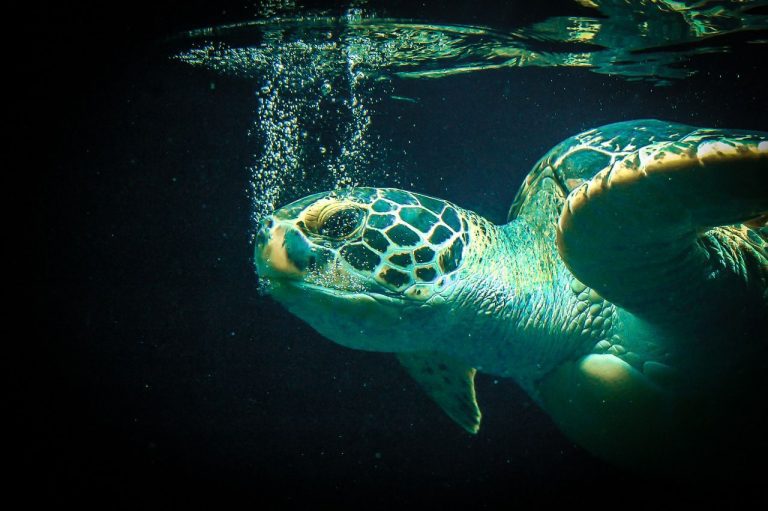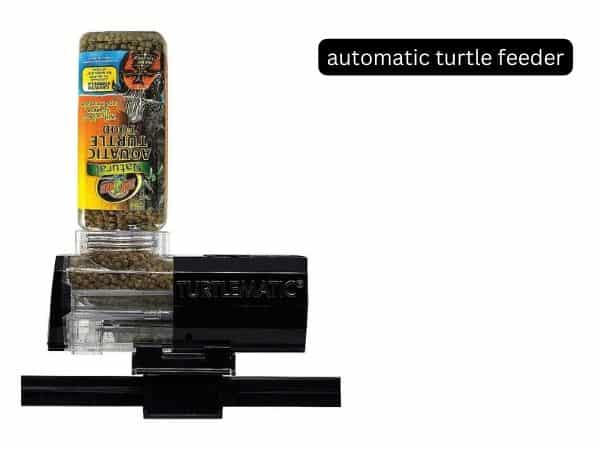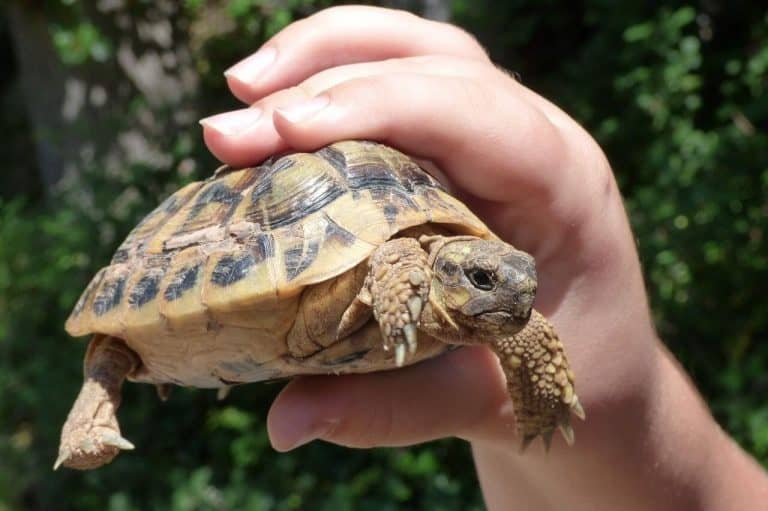Russian Tortoise Aquarium
Welcome to the fascinating world of the Russian tortoise aquarium! If you’re curious about bringing a touch of the wild into your own home, you’ve come to the right place. These amazing creatures make for delightful additions to any family.
But what exactly is a Russian tortoise? Well, let me tell you! Russian tortoises are small, charismatic reptiles native to the arid regions of Central Asia. Their compact size and friendly demeanor make them popular pets for reptile enthusiasts young and old.
In this guide, we’ll dive into the ins and outs of creating the perfect Russian tortoise aquarium. From setting up their enclosure to providing the right diet and care, we’ll cover it all. So, if you’re ready for an adventure into the world of Russian tortoises, let’s get started!
The Perfect Russian Tortoise Aquarium: A Guide to Creating a thriving Habitat
Welcome to our comprehensive guide on creating the perfect aquarium for your Russian tortoise! If you’re a tortoise enthusiast or considering adopting one as a pet, it’s essential to provide them with a suitable and comfortable habitat. In this article, we’ll explore everything you need to know about setting up a Russian tortoise aquarium, from the ideal tank size to the proper lighting and temperature requirements. Let’s dive in!
Choosing the Right Tank Size and Material
The first step in creating a suitable habitat for your Russian tortoise is selecting the right tank size and material. Depending on the size and number of tortoises you have, a good starting point is a minimum tank size of 40 gallons for a single tortoise. If you have multiple tortoises, you’ll need a larger tank to accommodate their needs adequately.
When it comes to tank materials, we recommend using glass or acrylic tanks. These materials provide excellent visibility and are easy to clean. Avoid using wire or mesh enclosures, as they can be harmful to your tortoise’s shell and may cause injury.
It’s essential to ensure proper ventilation in your tortoise aquarium. You can achieve this by installing a mesh lid or incorporating vents on the sides of the tank to allow for fresh air exchange.
Creating the Ideal Substrate and Hiding Spots
The right substrate is crucial for your Russian tortoise’s comfort and overall well-being. Opt for a substrate that mimics their natural habitat, such as a mix of topsoil, sand, and coconut coir or peat moss. This combination provides a suitable consistency for burrowing and digging behaviors.
Additionally, don’t forget to provide ample hiding spots for your tortoise. Include rocks, logs, and plant pots within the aquarium to create a safe space for them to retreat to when they need privacy or feel stressed. These hiding spots also promote natural behaviors and help them feel more secure in their environment.
Ensure you have a shallow water dish available in the tank for drinking and soaking. A separate dish can be used solely for soaking to maintain proper hydration levels and promote healthy shell growth.
Providing the Right Lighting and Temperature
Proper lighting and temperature are crucial for the health and well-being of your Russian tortoise. These reptiles require access to both UVA and UVB lighting to stimulate natural behaviors and proper calcium absorption.
Invest in a high-quality UVB bulb and a basking light to create a temperature gradient within the tank. The basking area should reach temperatures between 90-95°F (32-35°C), while the cool end can be around 75°F (24°C). It’s vital to monitor these temperatures regularly to ensure they are within the appropriate range.
Implement a timer to maintain a consistent light cycle of 12-14 hours of daylight and 10-12 hours of darkness. This mimics their natural day-night cycle and helps regulate their behavior and sleep patterns.
Feeding and Diet Recommendations
A well-balanced diet is crucial for the health of your Russian tortoise. Their diet should consist of a variety of leafy greens, vegetables, and occasional fruits. Dark, leafy greens like dandelion greens, collard greens, and spinach should make up the bulk of their diet.
Avoid feeding them foods high in protein and oxalates, such as beans, broccoli, and cabbage, as these can be harmful to their digestive system. Also, steer clear of feeding them iceberg lettuce, as it lacks nutritional value and can cause digestive issues.
Supplement their diet with calcium and multivitamin powders to ensure they receive all the necessary nutrients for optimal health. These supplements can be dusted on their food a few times a week.
Maintaining a Clean and Healthy Environment
Regularly maintaining and cleaning your Russian tortoise’s aquarium is vital for their overall health and well-being. Remove any uneaten food or soiled substrate daily to prevent bacterial growth. Spot-clean the tank as needed and perform a deep clean at least once a month or as recommended.
While cleaning, ensure you have a secure setup in place to temporarily house your tortoise to avoid any potential escapes or injuries. Use warm water and a mild reptile-safe cleaner to disinfect the tank and accessories thoroughly.
Monitoring and Regular Vet Check-Ups for Optimal Health
Last but not least, monitor your Russian tortoise closely for any signs of illness or distress. Keep an eye out for changes in appetite, abnormal behaviors, or respiratory issues. It’s essential to establish a relationship with a reputable reptile veterinarian who can provide regular check-ups and address any health concerns.
Remember, creating the perfect Russian tortoise aquarium requires time, effort, and dedication. By providing the right tank setup, lighting, temperature, and diet, you’ll be well on your way to creating a thriving habitat that promotes the overall well-being of your beloved reptile companion.
Common Mistakes to Avoid
Now that we’ve covered the essential aspects of setting up a Russian tortoise aquarium let’s take a look at some common mistakes to avoid:
1. Inadequate tank size
Many people underestimate the space needed for a Russian tortoise. It’s important to provide a tank that allows for proper movement and exploration. Inadequate tank size can lead to stress, stunted growth, and other health issues.
2. Improper lighting and temperature
Without proper lighting and temperature gradients, your tortoise may struggle to regulate their body temperature and receive essential UVB lighting. This can result in poor health, weak shells, and metabolic bone disease.
3. Inadequate hiding spots
Tortoises need hiding spots to feel secure and safe. Not providing enough hiding spots can cause stress, anxiety, and lead to behavioral issues.
4. Poor diet and lack of variety
A diet consisting of only a few types of vegetables or inadequate nutrition can lead to nutritional deficiencies and health problems. Offer a wide variety of greens, vegetables, and occasional fruits to ensure a balanced diet.
5. Neglecting regular vet check-ups
Although tortoises are generally hardy, they still need regular check-ups by a reptile veterinarian to monitor their overall health, detect any potential issues early on, and provide necessary treatments and vaccinations.
Creating a Natural-Looking Habitat
A crucial aspect of keeping a Russian tortoise is re-creating their natural habitat as closely as possible. Here are some tips for creating a natural-looking habitat:
1. Use natural substrates
Opt for natural substrates like topsoil, sand, and coconut coir or peat moss to mimic their natural environment. These substrates also allow for natural burrowing and digging behaviors.
2. Incorporate live plants
Include live plants in the aquarium to provide visual appeal and create a more natural habitat. Choose non-toxic plants that can withstand the tortoise’s browsing behavior.
3. Arrange rocks and logs strategically
Strategically place rocks, logs, and hideouts within the tank to create a realistic environment and provide hiding spots for your tortoise. These features also encourage natural behaviors and make the tank more visually appealing.
4. Add branches for climbing
Include branches or logs in the tank to provide opportunities for climbing and exercise. Ensure the branches are securely anchored to prevent any accidents.
By following these tips, you can create a natural-looking habitat that not only meets your Russian tortoise’s needs but also enhances the aesthetic appeal of their enclosure.
Common Questions About Russian Tortoise Aquariums
1. Can I keep multiple Russian tortoises in the same aquarium?
It is generally not recommended to keep multiple Russian tortoises in the same aquarium unless it is exceptionally large and provides enough space for each tortoise to establish their territory. Tortoises are solitary animals and may become territorial and stressed when kept together.
2. How often should I clean the tank?
You should spot-clean the tank daily by removing any uneaten food or soiled substrate. Perform a deep clean at least once a month or as needed, ensuring all accessories and the tank itself are thoroughly cleaned and disinfected.
3. Do Russian tortoises need a water dish?
Yes, Russian tortoises require a shallow water dish for drinking and soaking. Soaking is crucial for maintaining proper hydration levels and aiding in shell health and growth.
4. Can I use a heat mat instead of a basking light for warmth?
While a heat mat can provide supplemental heat, it is not suitable as the sole source of heat for your Russian tortoise. Tortoises require direct exposure to heat and UVB lighting for proper thermoregulation and vitamin D synthesis.
5. Do Russian tortoises need a humidifier?
Russian tortoises do not require a humidifier in their tank. However, maintaining proper humidity levels through substrates like coconut coir or peat moss can provide beneficial moisture for their shells and overall well-being.
Additional Resources
If you’re looking for more information and resources on creating a Russian tortoise aquarium, here are some recommended sources:
- 1. “Russian Tortoise Care Sheet” – Reptile Magazine
- 2. “Setting Up a Russian Tortoise Enclosure” – Tortoise Trust
- 3. “The Proper Enclosure for a Russian Tortoise” – The Spruce Pets
- 4. “Russian Tortoises: A Beginner’s Guide to Caring for These Amazing Reptiles” – ReptiFiles
Remember, providing a suitable and thriving habitat for your Russian tortoise is essential for their health and well-being. By following the guidelines mentioned in this article, you’ll be well on your way to creating a comfortable and stimulating environment for your beloved tortoise companion.
Key Takeaways: Russian Tortoise Aquarium
- Russian tortoises need a spacious aquarium to thrive.
- A 40-gallon tank is ideal for one tortoise.
- Provide a substrate made of calcium-based sand or coco coir.
- Include hiding spots and basking areas in the aquarium.
- Offer a varied diet of leafy greens, vegetables, and occasional fruits.
Frequently Asked Questions
Welcome to our FAQs about keeping Russian tortoises in an aquarium!
1. What size aquarium is suitable for a Russian tortoise?
For a single adult Russian tortoise, a 30-gallon (or larger) aquarium is recommended. If you plan to have multiple tortoises, consider a larger tank or even a custom-built enclosure. It should provide enough space for the tortoise to roam, explore, and feel comfortable. Avoid using glass, as tortoises tend to try to walk through it. Instead, opt for an aquarium made of acrylic, plastic, or wood.
Remember, the size of the enclosure is just as important as the length and width. The minimum dimensions for a Russian tortoise are about 4 feet by 2 feet. The more space you can provide, the happier and healthier your tortoise will be.
2. How should I set up the aquarium for my Russian tortoise?
Creating a suitable habitat is crucial for the well-being of your Russian tortoise. Start by adding a substrate layer at the bottom of the tank, such as a mix of soil and sand. This will allow your tortoise to dig and burrow. Next, place various hiding spots, such as rocks or small caves, to provide a sense of security.
Ensure that the temperature gradient in the enclosure is appropriate. Provide a basking area under a heat lamp, which should reach about 95°F (35°C), as well as cooler areas where the temperature stays around 75-85°F (24-29°C). Additionally, include a shallow water dish for drinking and soaking. You may also want to incorporate some plants to create a natural environment.
3. What should I feed my Russian tortoise in an aquarium?
Russian tortoises are herbivores, so their diet should consist mainly of leafy greens and vegetables. Offer a variety of options such as dandelion greens, kale, shredded carrots, and collard greens. Avoid foods high in oxalates, nitrates, and goitrogens, as they can be harmful to tortoises. Stay away from lettuce, spinach, and cabbage.
Supplement their diet with calcium and vitamin D3 by sprinkling their food with a powdered supplement. Provide fresh water at all times and mist the enclosure regularly to maintain proper hydration. It’s important to research and offer a balanced diet to ensure the health and longevity of your Russian tortoise.
4. Do Russian tortoises need UVB lighting in an aquarium?
Yes, Russian tortoises require UVB lighting to properly metabolize calcium and maintain overall health. UVB bulbs emit ultraviolet rays similar to those provided by the sun, allowing tortoises to produce vitamin D3. Without adequate UVB exposure, tortoises may suffer from metabolic bone disease and other health issues.
Place the UVB bulb in the enclosure, ensuring it’s easily accessible for the tortoise. The bulb should be replaced every six months to ensure it continues emitting sufficient UVB rays. Providing UVB lighting for 10-12 hours a day will help mimic natural sunlight and promote the well-being of your Russian tortoise.
5. How often should I clean the aquarium for my Russian tortoise?
Keeping the aquarium clean is essential for your tortoise’s health. Remove feces and uneaten food daily to prevent odors and the growth of harmful bacteria. Replace the substrate regularly to maintain cleanliness. How often you entirely clean the tank will depend on the size of the enclosure and the number of tortoises you have.
Perform a deep clean of the aquarium every 4-6 weeks. This involves removing your tortoise and all decor, thoroughly cleaning the tank, and replacing the substrate. Ensure you use a reptile safe cleaner and rinse everything well. This routine will help minimize odor, prevent infection, and provide a clean and healthy environment for your Russian tortoise.
Everything You Need To Know About Russian Tortoises!
Summary
So, in summary, a Russian tortoise aquarium can be a great home for your pet. Remember to provide the right habitat, including heat, light, and hiding spots. Fill the tank with substrate, offer fresh food and water daily, and create a secure enclosure. Lastly, spend time with your tortoise, give it proper care, and enjoy the companionship.
